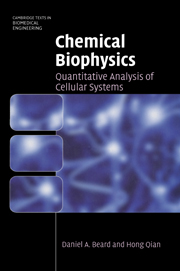Book contents
- Frontmatter
- Contents
- Preface
- Introduction
- Part I Background material
- Part II Analysis and modeling of biochemical systems
- 4 Enzyme-catalyzed reactions
- 5 Biochemical signaling modules
- 6 Biochemical reaction networks
- 7 Coupled biochemical systems and membrane transport
- Part III Special topics
- Bibliography
- Index
6 - Biochemical reaction networks
Published online by Cambridge University Press: 05 June 2012
- Frontmatter
- Contents
- Preface
- Introduction
- Part I Background material
- Part II Analysis and modeling of biochemical systems
- 4 Enzyme-catalyzed reactions
- 5 Biochemical signaling modules
- 6 Biochemical reaction networks
- 7 Coupled biochemical systems and membrane transport
- Part III Special topics
- Bibliography
- Index
Summary
Overview
Previous chapters have introduced methods for simulating the kinetics of relatively simple chemical systems, such as the phosphorylation–dephosphorylation system of Section 5.1 or the model of glycolysis illustrated in Section 3.1.4.2. However, the essential fact that biochemical reactants in solution exist as sums of rapidly interconverting species, as described in Chapter 2, is not explicitly taken into account in these simple models. As a result, influences of the binding of hydrogen and metal ions to reactants on thermodynamic driving forces and reactions' kinetics are not taken into account in these simulations.
Since a great deal of information is available regarding the thermodynamic and ion-binding properties of biochemical reactants, it is possible to construct simulations of biochemical systems that properly incorporate these data. Specifically, realistic simulations of biochemical systems require combining the following concepts into the simulations.
(i) A formal treatment of biochemical reactants as sums of distinct species formed by different hydrogen and metal ion binding states.
(ii) Conservation of mass based on reaction stoichiometry and multiple equilibria of biochemical reactions.
(iii) pH and ionic dependence on enzyme kinetics and apparent equilibria and thermodynamic driving forces for biochemical reactions.
This chapter will present a general methodology for incorporating these elements into a simulation of a biochemical system and illustrate the concepts based on the specific example of a kinetic model of the tricarboxylic acid (TCA) cycle.
- Type
- Chapter
- Information
- Chemical BiophysicsQuantitative Analysis of Cellular Systems, pp. 128 - 161Publisher: Cambridge University PressPrint publication year: 2008
- 2
- Cited by



